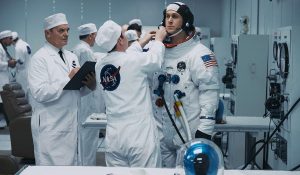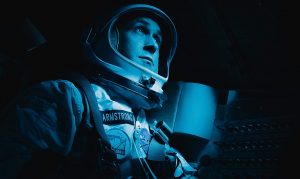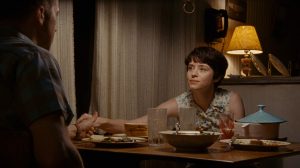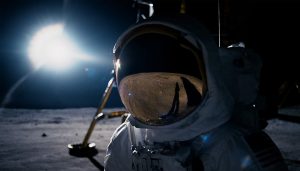![]() Most people know of astronaut Neil Armstrong as the first person to step foot on the moon. However, less are aware of the incredible work and dedication it took to get there. Director Damien Chazelle (La La Land, Whiplash) chronicles the man’s story in the biopic, First Man. The film expertly recreates the tension and peril that all of these explorers face as they head into the sky. Sadly, the human drama isn’t nearly as engrossing.
Most people know of astronaut Neil Armstrong as the first person to step foot on the moon. However, less are aware of the incredible work and dedication it took to get there. Director Damien Chazelle (La La Land, Whiplash) chronicles the man’s story in the biopic, First Man. The film expertly recreates the tension and peril that all of these explorers face as they head into the sky. Sadly, the human drama isn’t nearly as engrossing.
 The movie begins by following Armstrong (Ryan Gosling) as an aerospace engineer already engaged in testing equipment. After his young daughter succumbs to weakened health following a brain tumor diagnosis, he applies for a NASA position and becomes determined to help advance the country’s space program. Over the next several years, he works tirelessly on dangerous missions, often frustrating and upsetting wife Janet (Claire Foy). After several years, Armstrong is assigned his most dangerous and potentially significant mission of landing on the moon and walking on its surface.
The movie begins by following Armstrong (Ryan Gosling) as an aerospace engineer already engaged in testing equipment. After his young daughter succumbs to weakened health following a brain tumor diagnosis, he applies for a NASA position and becomes determined to help advance the country’s space program. Over the next several years, he works tirelessly on dangerous missions, often frustrating and upsetting wife Janet (Claire Foy). After several years, Armstrong is assigned his most dangerous and potentially significant mission of landing on the moon and walking on its surface.
 The flight sequences are very compelling. From the opening sequence, in which a test flight results in the pilot’s craft bouncing off the atmosphere, the film captures the innate danger involved. For much of the feature, the camera is kept within the cockpit with Armstrong seeing only what is visible through the glass (with the exception of the finale). This works well to create a sense of confined space and claustrophobia, even as the characters venture out into space. The movie makes the most of these sequences over the course of the story numerous problems are encountered. Every moment appears to threaten the lives of these astronauts.
The flight sequences are very compelling. From the opening sequence, in which a test flight results in the pilot’s craft bouncing off the atmosphere, the film captures the innate danger involved. For much of the feature, the camera is kept within the cockpit with Armstrong seeing only what is visible through the glass (with the exception of the finale). This works well to create a sense of confined space and claustrophobia, even as the characters venture out into space. The movie makes the most of these sequences over the course of the story numerous problems are encountered. Every moment appears to threaten the lives of these astronauts.
 Yet, while the film excels on a technical level when the characters are in orbit, the human drama leaves a lot more to be desired. Gosling portrays Armstrong likely as he was. Qualities portrayed include a muted personality and severe stoicism. This was a quiet man who clearly didn’t enjoy talking or expressing his thoughts and feelings, even to his wife. As a result, the character comes across as, well, more than a little stiff. To counterbalance this quality, the feature explains that the tragic death of his daughter may have caused him to shy away from others even within his own clan. Still, it seems a bit flimsy. His brief interactions with blunt personalities like Buzz Aldrin (Corey Stoll) end up making one wish the film had included more contrasting personalities.
Yet, while the film excels on a technical level when the characters are in orbit, the human drama leaves a lot more to be desired. Gosling portrays Armstrong likely as he was. Qualities portrayed include a muted personality and severe stoicism. This was a quiet man who clearly didn’t enjoy talking or expressing his thoughts and feelings, even to his wife. As a result, the character comes across as, well, more than a little stiff. To counterbalance this quality, the feature explains that the tragic death of his daughter may have caused him to shy away from others even within his own clan. Still, it seems a bit flimsy. His brief interactions with blunt personalities like Buzz Aldrin (Corey Stoll) end up making one wish the film had included more contrasting personalities.
Ultimately, the movie doesn’t do much to truly get inside his head. The conflict that grows between Armstrong and Janet appears equally muted and dramatically flat. Oddly enough, conversations between the lead and his fellow astronauts as well as with family are shot from an up-close perspective not unlike the missions themselves. Perhaps the director was attempting to maintain a feeling of intimacy with his adventurers, but it becomes a distraction as the camera always appears to be inches away from the lead’s face, whether we’re flying to the moon or sitting with him at a table.
 The final images on the moon finally open up the frame and show some sense of scope, as well as try to give an emotional release for Armstrong. By this point we’re so distanced from the central characters that the accomplishment itself doesn’t reach the emotional heights that it should.
The final images on the moon finally open up the frame and show some sense of scope, as well as try to give an emotional release for Armstrong. By this point we’re so distanced from the central characters that the accomplishment itself doesn’t reach the emotional heights that it should.
Anyone who is a space enthusiast or who wants to get a sense of what it might be like sitting in a confined aircraft will find some tense and captivating moments when the astronauts are striving into the unknown. It’s just a little unfortunate that the human drama featured in First Man never really lifts off and takes viewers to the same heights.


